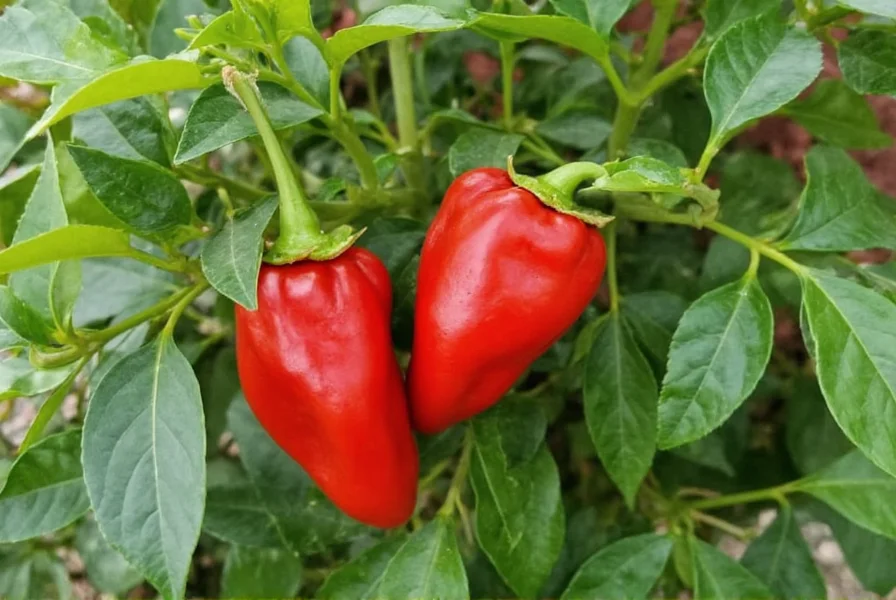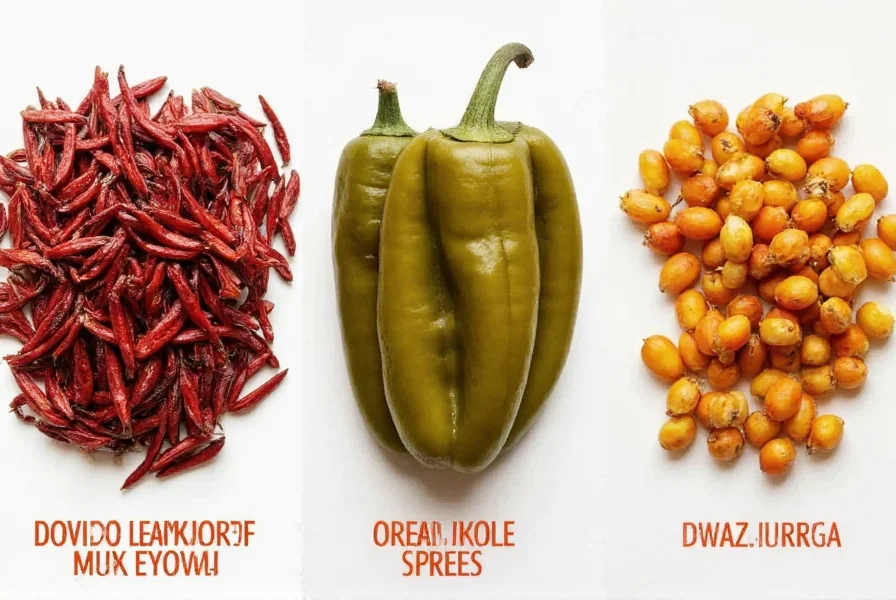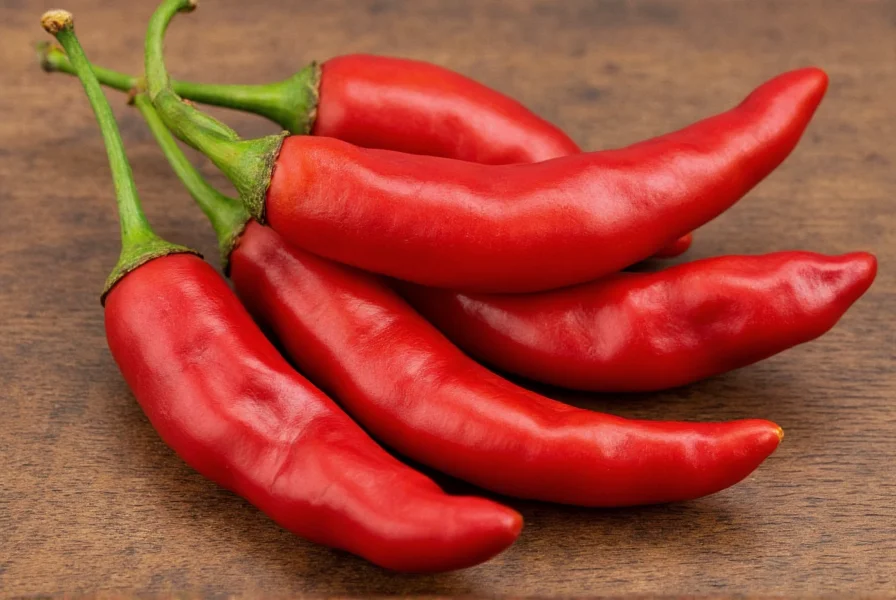Understanding the unique characteristics of goat horn peppers helps home cooks and gardening enthusiasts make the most of this versatile chili variety. Unlike many super-hot peppers, goat horn peppers provide a balanced heat experience that enhances dishes without overwhelming them. Their elongated, curved shape—typically 6-8 inches long with a noticeable taper at the tip—makes them easily distinguishable from other chili varieties.
Physical Characteristics and Maturation Process
Goat horn peppers begin their life cycle as slender green pods that gradually transform through yellow and orange stages before reaching their final vibrant red maturity. This maturation process significantly impacts both flavor and heat level. When harvested green, they offer a grassier flavor with slightly less heat, while fully ripened red peppers develop richer, fruitier notes with maximum capsaicin concentration.
| Characteristic | Details |
|---|---|
| Length | 6-8 inches (15-20 cm) |
| Heat Level | 30,000-50,000 Scoville Heat Units |
| Flavor Profile | Fruity with citrus notes, moderate earthiness |
| Maturity Time | 70-90 days from transplant |
| Common Uses | Sauces, stews, pickling, fresh salsas |
Heat Level and Flavor Profile Analysis
When evaluating goat horn pepper heat level, these chilies sit comfortably in the medium range of the Scoville scale—comparable to cayenne but generally milder than Thai bird's eye chilies. The heat builds gradually rather than hitting immediately, making them more versatile for dishes where you want sustained warmth rather than intense upfront fire.
The flavor profile distinguishes goat horn peppers from many other medium-heat varieties. They offer subtle fruity undertones with hints of citrus and berry, plus a mild earthiness that complements rather than dominates other ingredients. This complexity makes them particularly valuable for goat horn pepper culinary applications where flavor matters as much as heat.
Culinary Applications and Recipe Integration
Chefs appreciate goat horn peppers for their ability to enhance dishes without overwhelming them. For authentic Caribbean jerk preparations, these peppers provide the ideal heat foundation when blended with allspice, thyme, and scallions. Their moderate heat level makes them perfect for goat horn pepper sauce recipes that maintain complexity without excessive burn.
When incorporating into cooking, consider these techniques:
- For fresh applications: Remove seeds and membranes to reduce heat while retaining flavor
- For dried use: String and air-dry whole peppers for 2-3 weeks until brittle
- For oil infusions: Use low heat to slowly extract flavors without burning
- For pickling: Combine with vinegar, garlic, and spices for versatile condiments
Growing Goat Horn Peppers Successfully
Home gardeners can successfully cultivate goat horn peppers with proper attention to their tropical origins. These plants require 70-90 days of warm temperatures (75-85°F/24-29°C) to reach maturity. Start seeds indoors 8-10 weeks before your last frost date, using a well-draining soil mix with pH between 6.0-6.8.
Key growing considerations include:
- Provide 6-8 hours of direct sunlight daily
- Maintain consistent moisture without waterlogging
- Use balanced fertilizer every 2-3 weeks during growing season
- Support mature plants with stakes as branches become heavy with fruit
- Harvest when peppers reach full length and begin color transition

Comparative Analysis: Goat Horn vs Similar Varieties
Understanding how goat horn peppers compare to other common varieties helps in recipe substitution and selection. While often confused with cayenne peppers, goat horn varieties typically offer a more complex flavor profile with slightly less heat.
| Pepper Variety | Scoville Range | Flavor Characteristics | Best Culinary Uses |
|---|---|---|---|
| Goat Horn | 30,000-50,000 | Fruity, citrus notes, moderate earthiness | Jerk seasoning, salsas, pickling |
| Cayenne | 30,000-50,000 | Sharp, slightly smoky, straightforward heat | Hot sauces, spice blends, dried flakes |
| Serrano | 10,000-23,000 | Grassy, bright, immediate heat | Pico de gallo, fresh salsas, guacamole |
| Habanero | 100,000-350,000 | Tropical fruit, floral, intense heat | Caribbean hot sauces, exotic salsas |
When considering goat horn pepper vs cayenne, note that while their heat ranges overlap, goat horn peppers generally provide more nuanced flavor complexity. This makes them preferable for dishes where pepper flavor matters as much as heat level.
Storage and Preservation Methods
Proper storage extends the usability of goat horn peppers significantly. Fresh peppers keep for 1-2 weeks in the refrigerator's crisper drawer. For longer preservation:
- Drying: Air-dry or use a food dehydrator until brittle, then store in airtight containers
- Freezing: Chop and freeze in ice cube trays with water or oil for convenient cooking portions
- Pickling: Preserve in vinegar-based brine with garlic and spices for 3-6 months
- Oil infusions: Create chili oil by steeping in high-quality olive oil for flavorful cooking base

Where to Source Authentic Goat Horn Peppers
Finding authentic goat horn peppers requires knowing where to look. While not as common as jalapeños or bell peppers, they're increasingly available through:
- Specialty Latin American and Caribbean grocery stores
- Farmers' markets in regions with Caribbean communities
- Online seed catalogs for home growing (search for growing goat horn peppers at home)
- Some larger supermarket chains with extensive produce sections
When selecting fresh peppers, look for firm, glossy specimens without wrinkles or soft spots. The curvature resembling a goat's horn should be pronounced, and mature red peppers should feel heavy for their size.
Frequently Asked Questions
How hot are goat horn peppers compared to other common varieties?
Goat horn peppers measure 30,000-50,000 Scoville Heat Units, placing them in the medium-heat category. They're significantly milder than habaneros (100,000-350,000 SHU) but hotter than serranos (10,000-23,000 SHU). Their heat builds gradually rather than hitting immediately, making them more versatile for cooking than many other medium-heat peppers.
Can I substitute cayenne pepper for goat horn peppers in recipes?
Yes, you can substitute cayenne for goat horn peppers as their heat levels are similar (both 30,000-50,000 SHU). However, note that goat horn peppers offer more complex fruity notes while cayenne provides sharper, more straightforward heat. For best results in Caribbean dishes, use 1:1 substitution but consider adding a touch of citrus to mimic goat horn's flavor complexity.
What's the best way to reduce the heat of goat horn peppers while cooking?
To reduce heat while preserving flavor, remove the seeds and white membranes (placenta) where most capsaicin concentrates. Soaking sliced peppers in salted water for 15-20 minutes before use can also moderate heat. Cooking methods matter too—roasting or grilling can mellow the heat while enhancing natural sweetness, whereas raw applications deliver maximum spiciness.
How long do goat horn pepper plants typically produce?
In tropical climates where they're perennial, goat horn pepper plants can produce for 3-5 years. In temperate regions grown as annuals, they typically yield throughout the summer and early fall until first frost. With proper care including regular harvesting, a single plant can produce 25-40 peppers per season. Indoor overwintering in containers can extend production in colder climates.
Are goat horn peppers the same as Jamaican hot peppers?
While often used interchangeably in Caribbean cooking, goat horn peppers and traditional Jamaican hot peppers (like the Scotch bonnet) are distinct varieties. Goat horn peppers are longer and thinner with moderate heat (30,000-50,000 SHU), while Scotch bonnets are squatter with intense heat (100,000-350,000 SHU). Some regions do use "goat horn" colloquially for various hot peppers, causing confusion.











 浙公网安备
33010002000092号
浙公网安备
33010002000092号 浙B2-20120091-4
浙B2-20120091-4